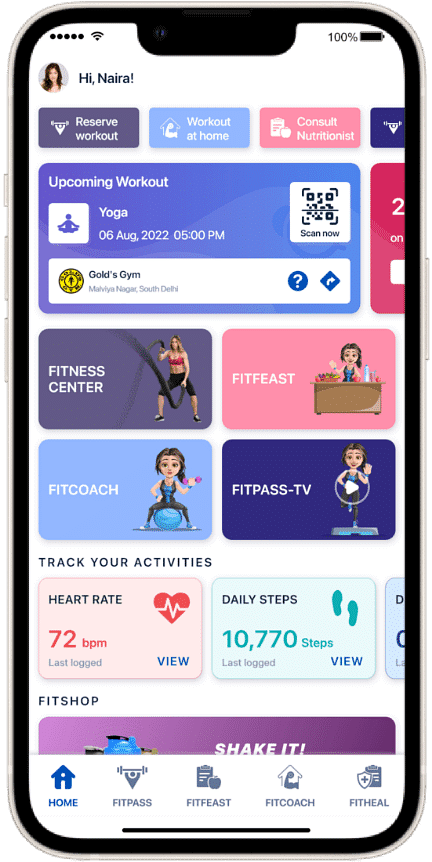Learn How To Do Surya Namaskar - 12 Poses Guide and Benefits
Table of Contents
Surya Namaskar, or Sun Salutation, is more than just a physical exercise; it is a profound practice that has been an integral part of the yogic tradition for centuries. Historically, Surya Namaskar was performed at dawn, facing the rising sun, as a gesture of reverence to the solar deity, Surya, who symbolises health, vitality, and consciousness. Practitioners believed that performing this ritual would bring them spiritual awakening and enlightenment.
Step-by-Step Guide: How to Do Surya Namaskar

Surya Namaskar comprises 12 steps, each corresponding to a unique posture. Here is a detailed guide on how to perform Surya Namaskar:
- Pranamasana (Prayer Pose): Begin by standing at the top of your mat with your feet together.Bring your palms together in front of your heart centre in a gesture of respect and intention.Ground yourself with deep, conscious breaths.
- Hasta Uttanasana (Raised Arms Pose): Inhale profoundly and sweep your arms overhead. Expand your chest and slightly arch your back, gazing up at your hands, inviting vitality into your body.
- Uttanasana (Standing Forward Bend): Exhale as you bend your knees slightly and fold forward from the hips. Touch the floor with your fingertips, or rest your hands on your shins. Let your head hang freely, releasing tension.
- Ashwa Sanchalanasana (Equestrian Pose): Inhale and bring your right foot back, placing it on the mat. Bend your left knee and ensure your left foot is between your hands. Look up, relax your shoulders, and feel the stretch.
- Plank Pose: Retain your breath as you bring your left foot back to meet the right, forming a straight line from your heels to your head. Engage your core and ensure your body is parallel to the ground.
- Ashtanga Namaskara (Eight-Limbed Salutation): Exhale and gently lower your knees, chest, and chin to the mat, keeping your hips elevated. This pose honours the earth and our connection to it.
- Bhujangasana (Cobra Pose): Inhale as you slide forward and lift your body from the heels to the crown of your head. Keep your elbows bent and close to your body, opening the heart space.
- Adho Mukha Svanasana (Downward Facing Dog Pose): Exhale and lift your hips up and back, extending your arms and legs. Press your heels down and let your head relax between your arms, forming an inverted 'V' with your body.
- Ashwa Sanchalanasana (Equestrian Pose): Inhale, step your right foot forward between your hands, and drop your left knee to the mat. Look up and engage your core for stability.
- Uttanasana (Standing Forward Bend): Exhale and move your left foot to your right. Fold forward, letting go of any residual stress.
- Hasta Uttanasana (Raised Arms Pose): Inhale and rise, reaching your arms overhead and bringing your spine into a slight backbend, welcoming energy and positivity.
- Pranamasana (Prayer Pose): Exhale and return to the starting position, bringing your hands before your heart. Seal in the practice's benefits and express gratitude to the sun.
Benefits of Surya Namaskar

The practice of Surya Namaskar offers numerous benefits, including:
- Cardiovascular Health: Surya Namaskar is akin to an aerobic workout that elevates the heart rate, promoting cardiovascular fitness. Improving blood circulation optimises the organs' function and helps detoxify the body by bathing every cell with nutrient-rich blood.
- Enhanced Respiratory Function: The deep, controlled breathing involved in Surya Namaskar increases lung capacity and strengthens the respiratory muscles. This practice is particularly beneficial for those with mild to moderate respiratory issues, as it encourages full oxygen exchange and can improve breathing patterns over time.
- Balanced Endocrine System: Surya Namaskar's various postures regulate the endocrine glands, especially the thyroid gland. They promote the balance of hormonal secretions, which aids in regulating metabolic processes, mood, and energy levels.
- Mental Clarity and Focus: The precise concentration required to perform each pose and synchronised breathing sharpen the mind and enhance cognitive functions. Regular practitioners report that the practice's meditative aspects often improve memory, focus, and mental clarity.
- Spiritual Growth: Surya Namaskar is not just a physical practice but also a spiritual one that symbolises the solar cycle and the eternal rhythm of the universe. It encourages mindfulness and presence, leading to a deeper connection with the self and the universe. Many people consider practising it as a moving meditation that can achieve profound inner peace and spiritual awakening.
- Muscular Strength and Flexibility: The Surya Namaskar sequence is a sequence of yoga poses that stretch and strengthen different muscle groups. The forward and back bends promote spinal flexibility, while the asanas strengthen the arms, legs, and core muscles.
- Improved Digestive Function: The alternate stretching and compression of the abdominal organs during Surya Namaskar massage the internal organs and stimulate the digestive tract. That can help alleviate digestive problems and improve gut health.
Surya Namaskar in Modern Yoga Practices

Surya Namaskar has become integral to modern yoga practices in today's fast-paced world. Various yoga styles, including Vinyasa and Hatha, often incorporate it due to its versatility and adaptability. Surya Namaskar serves as a warm-up routine, a standalone practice, or a way to transition between more complex asanas. Its adaptability makes it suitable for yogis of all levels and backgrounds.
Variations for Different Levels
Surya Namaskar can be modified to suit various levels of practitioners:
- Beginners: Start with fewer cycles and focus on getting the postures and breathing right. Use props like yoga blocks or straps to assist in the poses.
- Intermediate: Increase the number of cycles and hold each pose longer to deepen the practice.
- Advanced: For a more profound experience, integrate advanced variations of the poses and focus on the meditative aspect of the practice.
Common Challenges and Solutions

Beginners often face challenges such as stiffness, difficulty coordinating breath with movement, and lack of endurance. Here are some solutions:
- Warm-Up: Engage in a brief warm-up session to prepare your muscles and joints for the practice.
- Breath Awareness: Pay attention to your breathing pattern and synchronise it with the movements.
- Pace: Start slowly, and take your time with the poses. Your flexibility and endurance will improve with time.
Integrating Surya Namaskar into Your Routine

It is essential to make it a part of your daily routine to reap the full benefits of Surya Namaskar. Here are some tips:
- Consistency: Aim to practice Surya Namaskar simultaneously every day, preferably during sunrise.
- Gradual Progression: Start with a comfortable number of cycles and gradually increase as your body adapts.
- Mindfulness: Be present during the practice, focusing on your breath and the movements to achieve a meditative state.
Creating a Conducive Environment for Practice

Practising in a conducive environment is essential to maximise Surya Namaskar's benefits. Here are some tips to create a suitable space:
- Choose a Quiet Space: Find a quiet, clutter-free area where you can practice without distractions.
- Use a Comfortable Mat: Invest in a good-quality yoga mat with adequate cushioning and grip.
- Natural Light: Practice in a space with plenty of natural light or outdoors to connect with nature.
- Inspirational Elements: To inspire your practice, consider adding elements like plants, stones, or a sunrise picture.
Alignment with the Chakras

Surya Namaskar enhances physical strength and flexibility and aligns with the body's energy centres or chakras. Each posture in the sequence activates and balances specific chakras, promoting the free flow of energy throughout the body. For instance, heart-opening poses such as Hasta Uttanasana stimulate the Anahata (heart) chakra, fostering feelings of love and compassion. In contrast, grounding poses like Uttanasana activate the Muladhara (root) chakra, enhancing feelings of stability and security.
Impact on Mental Health

The benefits of Surya Namaskar extend beyond the physical body, profoundly influencing mental health. The practice is known to alleviate symptoms of depression and anxiety by promoting the release of endorphins, the body's natural mood elevators. The focus on breathwork and mindful movement during Surya Namaskar helps to calm the mind, reduce stress, and enhance overall emotional well-being.
If you’re looking for guidance and training to practice Yoga, get yourself a FITPASS membership and you can gain access to experts in 7500+ gyms and fitness studios across the country. Not only will you be able to find studios around you, but you also gain access to FITCOACH, an AI-led workout coach that can guide you through your routine through instructional videos.
How many times should I perform Surya Namaskar daily?
The number of Surya Namaskar cycles one should perform can vary based on individual fitness levels and experience. Beginners may start with 2-4 cycles and gradually increase to 12 or more. Consistency is critical, so it's more beneficial to do a few rounds every day rather than many rounds sporadically.
Can Surya Namaskar help with weight loss?
Yes, Surya Namaskar can be an effective exercise for weight loss when performed at a brisk pace. It increases the heart rate, which helps in burning calories. Somebody should combine significant weight loss with a healthy diet and other physical activities.
Is Surya Namaskar suitable for everyone?
While Surya Namaskar is a versatile practice suitable for most people, those with certain health conditions such as high blood pressure, hernia, or acute back conditions should seek medical advice before starting. Pregnant women and individuals recovering from surgery should also consult healthcare professionals.
What is the best time to do Surya Namaskar?
People traditionally perform Surya Namaskar at sunrise to salute the sun. You can practice it at any time of the day if you have an empty stomach. Somebody should do evening practice at least 2-3 hours after a meal.
Can I do Surya Namaskar during pregnancy?
Avoiding Surya Namaskar during pregnancy is generally recommended, especially after the first trimester. However, somebody can modify the practice under the guidance of a qualified prenatal yoga instructor.
How many surya namaskar to do?
Performing 12 rounds of Surya Namaskar (Sun Salutation) daily is considered beneficial for overall health and fitness. It combines yoga postures, breathing, and meditation, improving flexibility, strength, cardiovascular health, and mental clarity, while aiding in weight management.
How many times to do surya namaskar?
Surya Namaskar can be performed as many times as comfortable, starting with 3-5 rounds and gradually increasing. Regular practice enhances flexibility, strength, and cardiovascular health. Aim for consistency and listen to your body's signals to avoid overexertion.
How to do surya namaskar?
To do Surya Namaskar, stand in prayer pose, inhale to raise arms, exhale to forward bend, then move through a series of lunges, planks, and downward dogs, synchronising breath with movement. Repeat the sequence for a comprehensive full-body workout and meditative flow.
What are the benefits of surya namaskar?
Surya Namaskar offers numerous benefits, including improved flexibility, strength, and cardiovascular health. It aids in weight management, enhances mental clarity, reduces stress, and stimulates various bodily systems, contributing to overall well-being and balanced energy levels.
How to do yoga at home?
To do yoga at home, create a quiet space, use a yoga mat, and follow online tutorials or apps. Start with basic poses, focusing on breath and form. Practise regularly, listen to your body, and gradually increase the duration and complexity of your sessions for optimal benefits.


